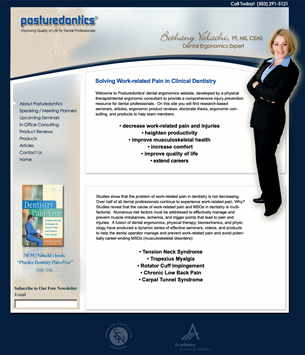 Featured Article | | |
Ten Low-Cost Ways to Ergonomize Your Operatory
Making ergonomic modifications in your operatory doesn't have to cost a fortune. Here are 10 easy-to-implement and economical changes to help you work more comfortably, prevent pain and extend your career.
|
|
Join Our List
|
 |
| Ergo-Tips
Protect Your Back. Whenever you must leave the lumbar support of your chair, remember to pull your navel to your spine as you pivot forward at the hips. This engages your transverse abdominal muscles-your natural 'backbelt'!
|
|
Double Articulating Headrests. For maxillary procedures, take the time to angle the headrest up into the occiput. This will relax the patient's neck muscles, position the chin higher and enable better viewing of the oral cavity.
Alternate between standing and sitting during procedures to reduce back pain! This is especially important for assistants, who have little opportunity to change positions during the workday. Standing uses different groups of muscles than sitting, so avoids overworking one area of the body.
| |
|
|
Low-Cost Ergonomic Modifications Issue #5 |
|
| Greetings!
In these uncertain economic times, every little bit helps to cut costs. You can start right now making ergonomic improvements to your operatory for minimal or no expense! I hope you find Ergo-News interesting and helpful.
Bethany Valachi, PT, MS, CEAS
Dental Ergonomic Consultant/Lecturer/Physical therapist | |
FIND FREE RESOURCES ON POSTUREDONTICS' NEW WEBSITE! |
We are excited to introduce our new website! On it, you'll find FREE educational resources, including: 
At the bottom of the Homepage, you can download a FREE article, "The 6 Keys to Wellness in Dentistry: Essential Steps to Improve your Musculoskeletal Health". Click here. |
|
THUMBS-UP ERGONOMIC STRATEGY |
Free is a very good price. And many of the ergonomic improvements you make don't have to cost a dime. How you move in the operatory can either benefit or worsen your musculoskeletal health. Here is an important intervention for preventing shoulder pain by keeping the joint in it's neutral anatomical position while moving in the operatory. I call it the Thumbs-Up exercise.
A common moving error is reaching for the operatory light or delivery system in a palms-down position. This causes excessive compression in the sub-acromial space of the shoulder and can lead to shoulder dysfunction. Try this simple exercise: While sitting, roll your shoulder slightly forward, as though reaching for the light, and very slowly raise your arm straight forward in a palms-down position. Most individuals will feel an uncomfortable 'clunk' just after the arm passes the horizontal plane. Now rotate your hand to a thumbs-up position. Repeat the test and you will notice there is no clunk at all, and your shoulder joint glides smoothly into full flexion. 
You may notice that some operatory lights have a vertical handle. Was this design intended to address ergonomics of the shoulder? It is hard to say, but regardless, this orientation of the handle encourages proper movement of the shoulder. While this shoulder movement is easily preserved when reaching for handpieces, which are usually positioned vertically on the delivery system, it becomes more challenging when retrieving instruments lying flat on the delivery system. Strive to reach toward the delivery system (especially if it is positioned to one side of the dentist) with a thumbs-up position, and do not rotate the hand to a palms-down position until the very last moment to retrieve the instrument. This side-reaching pattern is challenging, but with practice can easily become a habit in the operatory. Palms-down reaching is especially damaging on the shoulder when performed repeatedly to one side (abduction) and even worse when reaching above elbow height. |
| Do you have friends who would benefit from this newsletter? Why not forward it now? |
Posturedontics, LLC was developed by a dental ergonomic consultant/physical therapist and clinical dentist to provide dental professionals with quality, research-based ergonomic education, products and resources. We value your input and ideas for future newsletters.
Please send us your ergonomic success stories! | |
|
|
|